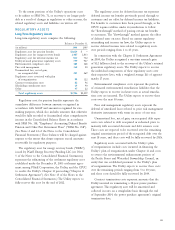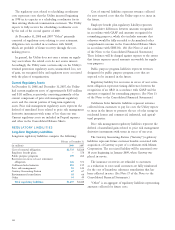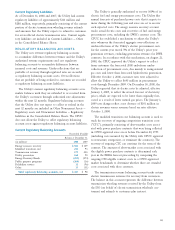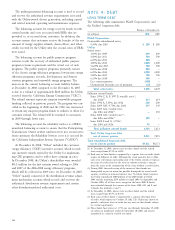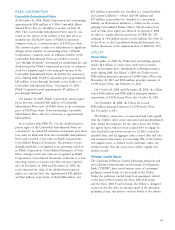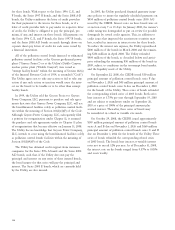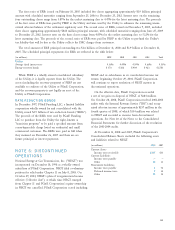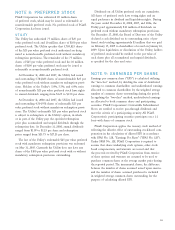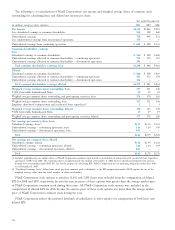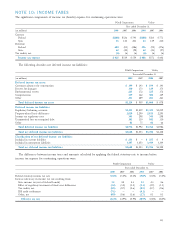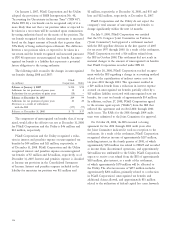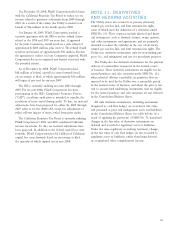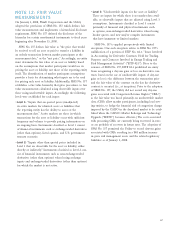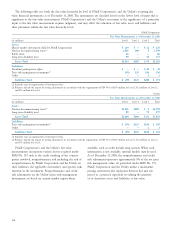PG&E 2008 Annual Report Download - page 110
Download and view the complete annual report
Please find page 110 of the 2008 PG&E annual report below. You can navigate through the pages in the report by either clicking on the pages listed below, or by using the keyword search tool below to find specific information within the annual report.108
Commercial Paper Program
The Utility has a $1.75 billion commercial paper program,
the borrowings from which are used primarily to cover
fl uctuations in cash fl ow requirements. Liquidity support
for these borrowings is provided by available capacity under
the Utility’s revolving credit facility, as described above.
The commercial paper may have maturities up to 365 days
and ranks equally with the Utility’s other unsubordinated
and unsecured indebtedness. Commercial paper notes are
sold at an interest rate dictated by the market at the time
of issuance. At December 31, 2008, the average yield was
approximately 2.48%.
NOTE 5: ENERGY RECOVERY
BONDS AND RATE
REDUCTION BONDS
ENERGY RECOVERY BONDS
In conjunction with the Chapter 11 Settlement Agreement,
the Utility was authorized to recover $2.2 billion, result-
ing in a regulatory asset. (See Note 3 of the Notes to the
Consolidated Financial Statements.) To lower the cost borne
by customers, ERBs were issued to fi nance the regulatory
asset at an interest rate lower than the rate of return allowed
on the regulatory asset. In 2005, PG&E Energy Recovery
Funding, LLC (“PERF”), a wholly owned consolidated sub-
sidiary of the Utility, issued two separate series of ERBs in
the aggregate amount of $2.7 billion supported by a dedi-
cated rate component (“DRC”). The proceeds of the ERBs
were used by PERF to purchase from the Utility the right,
known as “recovery property,” to be paid a specifi ed amount
from a DRC. DRC charges are authorized by the CPUC
under state legislation and will be paid by the Utility’s
electricity customers until the ERBs are fully retired. Under
the terms of a recovery property servicing agreement, DRC
charges are collected by the Utility and remitted to PERF for
payment of the bond principal, interest, and miscellaneous
expenses associated with the bonds.
The revolving credit facility includes usual and custom-
ary covenants for credit facilities of this type, including
covenants limiting liens, mergers, sales of all or substantially
all of PG&E Corporation’s assets, and other fundamental
changes. In general, the covenants, representations, and events
of default mirror those in the Utility’s revolving credit facil-
ity, discussed below. In addition, the revolving credit facility
also requires that PG&E Corporation maintain a ratio of
total consolidated debt to total consolidated capitalization
of at most 65% and that PG&E Corporation own, directly
or indirectly, at least 80% of the common stock and at least
70% of the voting securities of the Utility. At December 31,
2008, PG&E Corporation met both of these tests.
UTILITY
Revolving Credit Facility
The Utility has a $2 billion revolving credit facility with
a syndicate of lenders that expires on February 26, 2012.
Borrowings under the revolving credit facility and letters of
credit are used primarily for liquidity and to provide credit
enhancements to counterparties for natural gas and energy
procurement transactions. The Utility treats the amount
of its outstanding commercial paper as a reduction to the
amount available under its revolving credit facility so that
liquidity from the revolving credit facility is available to
repay outstanding commercial paper. As of December 31,
2008, the commitment from Lehman Bank represented
approximately $60 million, or 3%, of the revolving credit
facility. Lehman Bank has failed to fund its portion of bor-
rowings under the revolving credit facility since September
2008 and the Utility does not expect that Lehman Bank will
fund any future borrowings or letter of credit draws.
The revolving credit facility includes usual and customary
covenants for credit facilities of this type, including covenants
limiting liens to those permitted under the senior notes’
indenture, mergers, sales of all or substantially all of the
Utility’s assets, and other fundamental changes. In addition,
the revolving credit facility also requires that the Utility
maintain a debt to capitalization ratio of at most 65% as
of the end of each fi scal quarter. At December 31, 2008, the
Utility met this ratio test.





